

The Catholic Church and the Renaissance" Even though there are some sharp contrasts, for the most part, the influence and prestige of the Catholic Church was declining.

The humanistic thinking did accept the older church institutions that were deeply rooted in traditions and traditional ways of thinking. In the past, the Catholic Church had been an important part of the system that was based on the allegiances between lords and vassals (the feudal system). During the Renaissance the demands of society shifted and became based on money instead of allegiances. The church had a difficult time adjusting to this new way of thinking. For example, the parish priests and monks had long served as the religious teachers of the peasants, but as the commercial class began to grow, the priests found that they knew very little about the needs of this new class of people.
Www.mapsofwar.com/images/EMPIRE17.swf. Renaissance Art - Facts & Summary. By the end of the 15th century, Rome had displaced Florence as the principal center of Renaissance art, reaching a high point under the powerful and ambitious Pope Leo X (a son of Lorenzo de’ Medici).
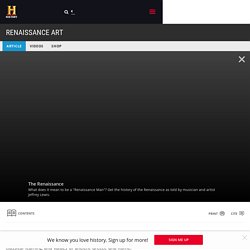
Three great masters–Leonardo da Vinci, Michelangelo and Raphael–dominated the period known as the High Renaissance, which lasted roughly from the early 1490s until the sack of Rome by the troops of the Holy Roman Emperor Charles V of Spain in 1527. Leonardo (1452-1519) was the ultimate “Renaissance man” for the breadth of his intellect, interest and talent and his expression of humanist and classical values. Leonardo’s best-known works, including the “Mona Lisa” (1503-05), “The Virgin of the Rocks” (1485) and the fresco “The Last Supper” (1495-98), showcase his unparalleled ability to portray light and shadow, as well as the physical relationship between figures–humans, animals and objects alike–and the landscape around them. MrsBotelho - Unit 4- Renaissance & Reformation. CSI: Italian Renaissance. City-States of the Italian Renaissance. During the Middle Ages, much of Italy was controlled by the Holy Roman Empire.
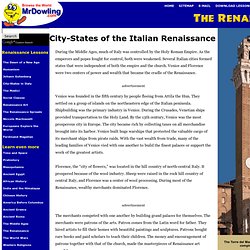
As the emperors and popes fought for control, both were weakened. Several Italian cities formed states that were independent of both the empire and the church. Venice and Florence were two centers of power and wealth that became the cradle of the Renaissance. History of the Renaissance in Europe: A rebirth, renewal, rediscovery. The Renaissance Beginning And Progress Of The Renaissance Edited By: R. A. Guisepi. CSI: Italian Renaissance. Web Links - The Renaissance. Renaissance. The Antiquarium - Antique Print & Map Gallery - Covens & Mortier - Florence - Copperplate Engraving. Florence. The Renaissance really gets going in the early years of 15th century in Florence.

In this period, which we call the Early Renaissance, Florence is not a city in the unified country of Italy, as it is now. Instead, Italy was divided into many city-states (Florence, Milan, Venice etc.), each with their own form of government. Now, we normally think of a Republic as a government where everyone votes for representatives who will represent their interests to the government (remember the pledge of allegiance: "and to the republic for which it stands... "). However, Florence was a Republic in the sense that there was a constitution which limited the power of the nobility (as well as laborers) and ensured that no one person or group could have complete political control (so it was far from our ideal of everyone voting, in fact a very small percentage of the population had the vote).
The Italian Renaissance and Italy's Transformation Video - Lesson and Example. Out of the Middle Ages. In the feudal structure of the Middle Ages, the nobles who lived in the country provided the king with protection in exchange for land.

Peasants worked the land for the nobles, for which they received protection and their own small parcels of land. These rural peasants worked from sunup to sundown, but even the nobles had few creature comforts. In feudal cities, where there was a small middle-class population, life was a little easier and individuals had the freedom to pursue whatever trade or industry they liked. In the late Middle Ages, when the threat of invasion from barbarians had lessened, people left the country for towns and cities so they could engage in more profitable pursuits.
The Plague Begins. Exploration and Trade. You are the owner of a large sailing ship.
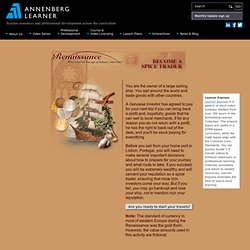
You sail around the world and trade goods with other countries. A Genoese investor has agreed to pay for your next trip if you can bring back a profit and, hopefully, goods that he can sell to local merchants. Greece. The Renaissance Art Period - About.com Art History. We all know what the Renaissance was, correct?
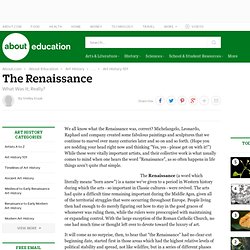
Michelangelo, Leonardo, Raphael and company created some fabulous paintings and sculptures that we continue to marvel over many centuries later and so on and so forth. (Hope you are nodding your head right now and thinking "Yes, yes - please get on with it! ") While these were vitally important artists, and their collective work is what usually comes to mind when one hears the word "Renaissance", as so often happens in life things aren't quite that simple. The Renaissance (a word which literally means "born anew") is a name we've given to a period in Western history during which the arts - so important in Classic cultures - were revived. The arts had quite a difficult time remaining important during the Middle Ages, given all of the territorial struggles that were occurring throughout Europe. The Renaissance: Was it a Thing? - Crash Course World History #22.
Renaissance for Kids: Timeline. History >> Renaissance for Kids 1300 - 1400 Proto-Renaissance 1305 - Giotto completes his work on the Scrovegni Chapel in Padua.
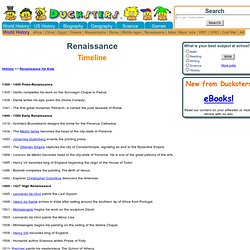
History for Kids: How did the Renaissance start? History >> Renaissance for Kids The Renaissance is generally considered to have started in Florence, Italy around the years 1350 to 1400.
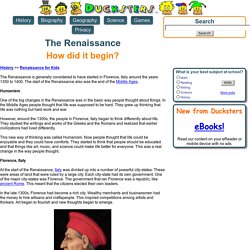
The start of the Renaissance also was the end of the Middle Ages. Humanism. Quiz: Daily Life in the Renaissance. Daily Life In The Renaissance - Renaissance Quest. Life during the Renaissance (1450-1600) was interesting.
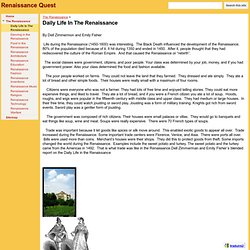
The Black Death influenced the development of the Renaissance. 80% of the population died because of it. It hit during 1350 and ended in 1450. Renaissance, The Elizabethan World - Life in Tudor England. Odyssey Online: Greece.